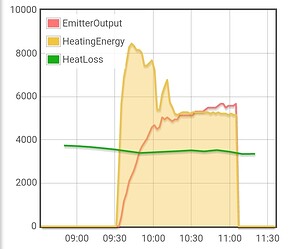Hi All @SarahH @matt-drummer @Timbones
First, Sarah,
A= Problably have a great impact and on top you run with an external Roomstats - you seem to get a completely different type of control - this is actually confirmed by my supplier.
B= I have been fuzzing around with 2093 (No use for me to change 2091/2092 since I have and use the MIM controller for room stat) and I can not measure any significant change in Cycling - I went from 8 minutes cycle to 9 minutes - so a little improvement, but still over 6 cycles per hour.
C= My supplier have stated that a 3rd. party room stat could also be in the game to force the ASHP to act different than it does now - I will wait for their reply to an email that will be sent tomorrow.
Tim, I have 8 emitters + Floorheating (FH) - FH is around 10 m2 - rest of the house is 116 m2 so total of 126 m2.
I have 100 mm. insulation in the floor, FH is 300 mm. - 100+100 mm. insulation in walls and 300-350 mm. at the roof - All windows are latest 0 energy windows.
According to my calculation - I have around 3500 watts for my use in the house at 38/35/20 degC.
dt at 3 degC - which is quite stable when the ASHP runs - goes a bit over - up to 4 and a bit under 2,95 or so - so during that 8 minutes cycle it is steady in around 3,5 minutes after it have started the compressor and until I can see the compressor shuts down - rest of the time is pwering up, and down - and around 30 sek. where it is completely off - No water circulation no nothing…
With this Samsung I have steady production around 42-45 degC, when I push it up there on manual. Then the house climbs to around 26-27 degC and that is killing me…

I would prefer a dt at around 5 but I am not able to make that - if I was able to slow down flow, I might would be able to do it, but that will affect the COP in a negative manner - so I surely wont do (Accept) that.
I was told that flow was king when it comes to ASHP - and I replaced all the valves on the emitters from Danfoss RA-N to RA-G - this way I get 2,5 more flow through the emitter - this way I have reduced flow temp from around 40-43 degC to 32-34 at 7 degC outside temp. Significant savings in kwh.
Allthough I do agree, my emitters could be better and no dought, if I replaced all to 3 layers - I problably could get a better dt - I still dought it would be like magic and solve all the cycling issues I experince.
My calculation leads to the ASHP is to large - 5 Kw would have fitted better. On top we deal with an 8 kw which uses the same Scroll compressor that is to found in the 2 larger ASHP in the series - 12 and 14 kw - So minimum power is around 0,8 kwh input which produces around 3,2 kwh at cop at 4 - which is the minimum COP I readout during production - many times it is 4,5 up 5,2 - this produces more heat power than my emitters are able to consume.
I am not so damn strong in the theory of the different factors we are dealing with - but my guess is that if the amount of produce kw matches or are below the emitters capacity - we would look at a heatpump that can get rid of the heat produced and that way create slightly better dt and COP because it will at no doughts, get longer runs…
If I am on a wrong track - let me know 
/Arne

